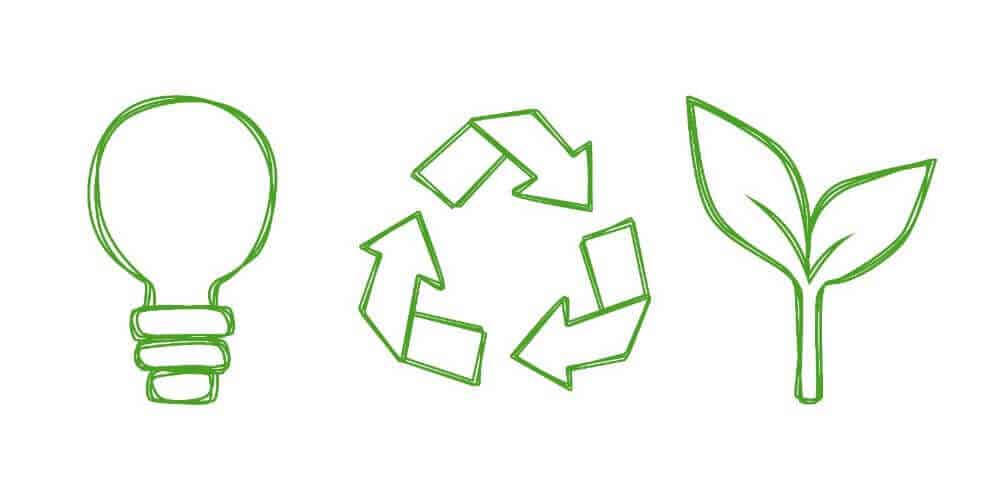
We all know the importance of recycling and the impact it has on the environment. But do you know how it works? Recycling involves the complex process of sorting, collecting, and recycling. From this process, new products are created and waste is reduced. In this blog, you’ll learn all about recycling – from how it works to how to make sure you’re doing it right. So let’s get into how is recycling sorted…
Recycling – how it works?
The recycling process is complex. After recyclables are picked up from the curbside or drop-off point, they are taken to a materials recycling facility (MRF). Here they are sorted and separated into different types of materials: paper, plastic, glass, and metals. A big spinning drum called an Eddy Current Separator creates a strong magnetic field called an induction field that repels aluminum away while plastics continue on the conveyor belt. The materials are then taken to a recycling facility, where they are broken down and converted into raw materials that can be used to make new products. But how is recycling sorted…
How are recyclables sorted?
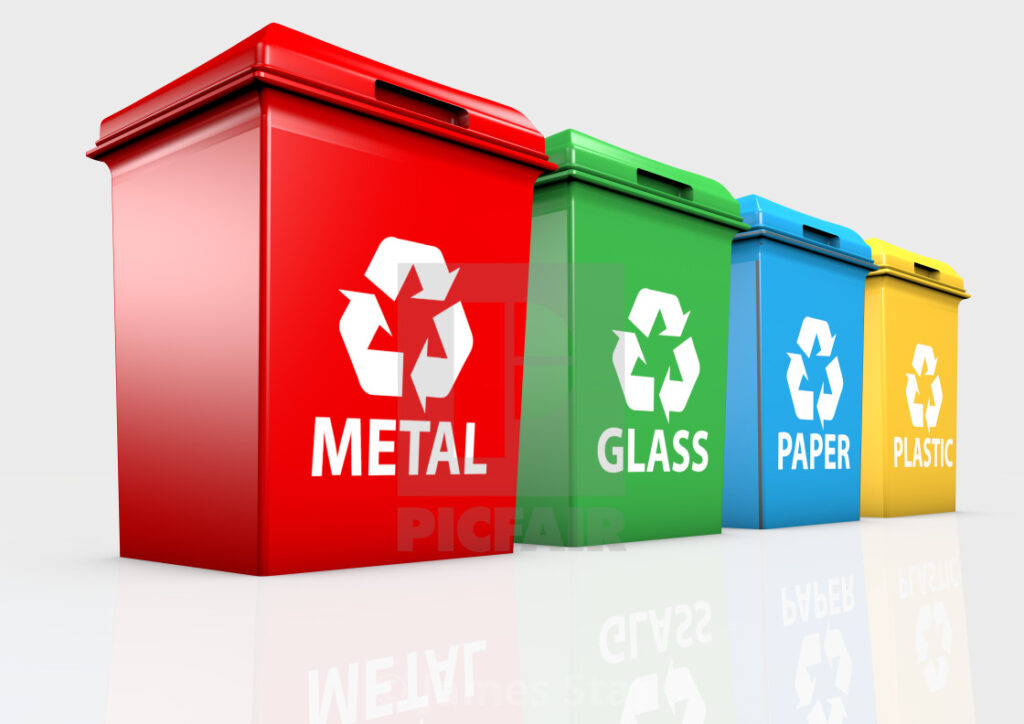
The sorting of recyclables usually involves several different steps. For example, metals, glass, and plastics are sorted into separate containers or onto conveyor belts. The materials are then sorted by size and separated by color. Sorting equipment such as magnets, infrared scanners, and optical sorters are used for this.
Industrial recycling
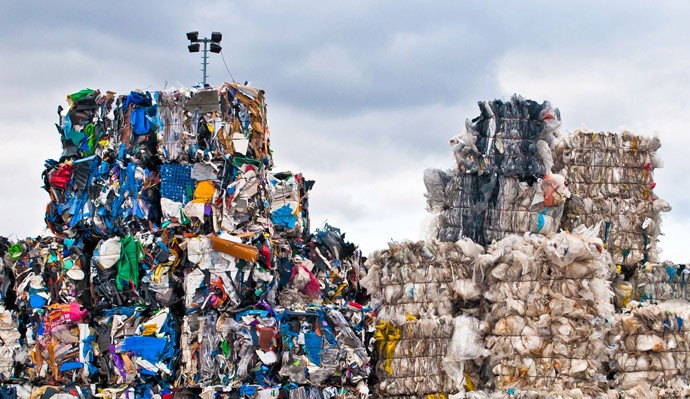
Recycling is the process of sorting, collecting, and recycling materials that would otherwise be discarded as waste. The first step in recycling is sorting recyclable materials from non-recyclable materials. Recycling bins, usually labeled for specific materials, are used to sort the materials at the source. After collection, the materials are transported to a materials recovery facility for further sorting and recycling.
The facility uses a variety of sorting methods to separate materials by type, including manual sorting and mechanical sorting methods. One common mechanical separation method is the use of a magnet to sort ferrous metals from non-ferrous metals. Vortex-current separators are also widely used for sorting non-ferrous metals such as aluminum. Optical sorters, which use cameras and sensors, are often used to sort materials such as plastic bottles by color or resin type.
The eddy current separator is specialized equipment that uses a magnetic field to sort non-ferrous metals such as aluminum cans. Material recycling facilities are a key part of the recycling process that sort and recycles recyclables. The purpose of sorting recyclables is to separate different types of materials to make recycling easier.
Pressing is the process of pressing paper and cardboard into dense, usable blocks, which are then sent to paper mills for recycling. The separator uses a magnetic field to attract ferrous metals, which are then collected and sent for recycling. Recycling facilities are designed to sort and recycle materials for re-production into new products.
Infrared sensors are also often used in sorting recyclables to detect certain types of materials, such as plastics. Single-stream recycling, where all recyclables are mixed, is becoming more common, but it requires better sorting methods to separate materials. Recycling plants use a variety of methods to sort materials, such as air classifiers, screens, and ballistic separators.
The use of robotics and artificial intelligence is becoming more common in sorting recyclables to improve the speed and accuracy of the process.
Know what to discard
One of the most important steps in the recycling process is sorting recyclables. To make sure you recycle correctly, it is important to know what types of materials can and cannot be recycled. Many items cannot be recycled, such as plastic bags, Styrofoam, and glass with food scraps.
Each plastic bottle is cleaned and shredded before being sorted by resin type.
In addition, some materials may be contaminated with non-recyclable materials, making them unsuitable for recycling.
It is very important that people properly sort recyclable materials so that the recycling process is efficient and effective. Be sure to contact your local recycling center to find out what materials they accept.
How is recycled plastic sorted?

The process of sorting plastic materials is a bit more complicated. All plastics are sorted by numbers – from 1 to 7 – depending on the type of resin the material is made of. Each number designates a different type of plastic and has different properties, such as strength and flexibility. This helps determine what type of material can be used to make the plastic. Most plastics, such as water bottles, shampoo bottles, and food containers, are made from Type 1 and Type 2 plastics.
What are the steps in the recycling process?
The recycling process is broken down into five main steps: Collection, Sorting, Recycling, Production, and Consumption.
Collection:
Recyclables are collected at drop-off points or the roadside.
Sorting:
Recyclables are sorted and separated into different materials.
Recycling:
Materials are crushed into crude form and transported to a recycling center.
Production:
Raw materials are converted into new products.
Consumption:
Recycled products are purchased and used by consumers.
How is glass sorted for recycling?
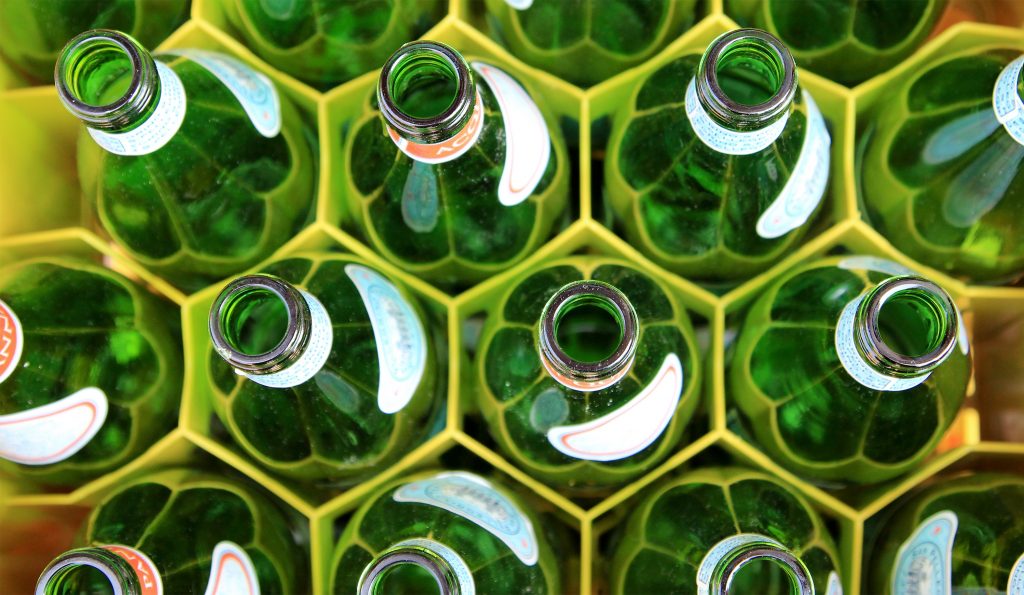
Sorting glass is similar to sorting plastic. Glass is sorted by color because the components in glass are different for each color. Clear, green, and brown glass are the three most common colors that are sorted into different containers. Sorting by color allows different types of glass to be recycled and reused
Sorting your waste at home
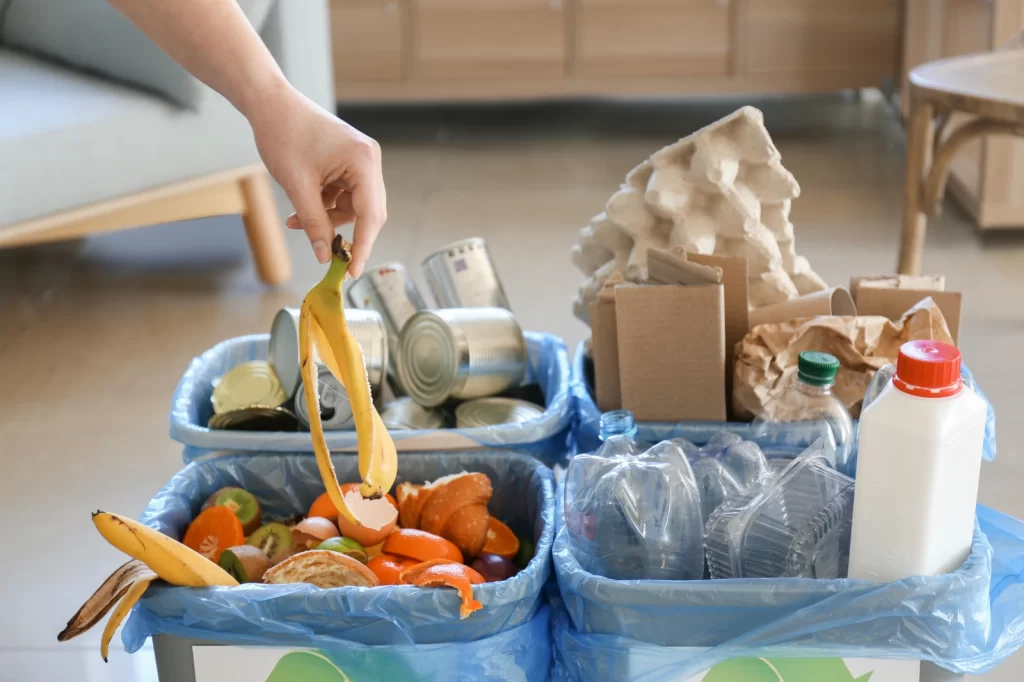
The key to effective and efficient recycling is knowing what you can and cannot recycle, and knowing how to sort your waste at home. Start by following these simple steps:
- Collect all waste in a separate container.
- Separate the waste into different materials such as paper, glass, plastic, and metal.
- Check with your local recycling center to make sure you are sending the right materials.
Advanced optical technologies in recycling sorting can also be used to identify and separate different plastics of colors, allowing for more efficient recycling. Properly sorting your waste and using a designated recycling bin can greatly aid in the separation of household and industrial waste. Once the household and industrial waste are separated, it’s important to bale the materials to maintain their purity, which is crucial for their recycling process and to get the best value out of them.
Material recovery is the process of separating and collecting recyclable materials from the household and industrial waste stream. Food tins are a common material found in the recycling sorting process, recycling is a process as they are widely used for packaging food products.
Recycled or reused items are separated domestically and internationally and turned into new ones. Paper and cardboard go plastic or metal heavier glass items eddy current separator creates. At Material Recovery Facilities (MRFs), items are sorted by hand and by machines. Another method for sorting aluminum is to use an eddy current separator, which uses a magnetic field to repel the aluminum. MRFs use a combination of manual labor and advanced technology to sort and separate recyclable materials. Once sorted, the recycling material is then processed and prepared for shipping. These materials are then bailed or compacted into large bundles for transportation. The bails are then transported domestically and internationally to be recycled or reused. The recycling material is further sorted by type and composition before being processed further.
The aluminum cans, for example, are crushed and baled for shipping to aluminum recycling facilities. The sorted materials are then processed to remove any impurities and contaminants. Once the materials are cleaned and processed, they are ready to be recycled or reused. Recycled aluminium, for example, can be used to make new aluminium products such as cans, foil, and automotive parts.
The recycling and sorting process is crucial for reducing waste and preserving natural resources. The current separator creates a strong magnetic field. Sent along a conveyor belt flat materials scrap metal. Harder to recycle one bin of heavier items. New steel hdpe material is sent material goes.
Each type of material is separated by using different techniques, for example, paper and cardboard are separated using a pulping process. The use of advanced sorting technology, such as sensor-based sorting, is becoming more common in recycling plants to improve the efficiency and effectiveness of the sorting process.
Compostable materials such as food waste and yard waste is sorted out of the recycling stream and sent to composting facilities. out of the recycling stream and sent to composting facilities. Recycling is sorted using a variety of methods, including manual sorting and mechanical processes. The process of sorting and recycling plant is constantly evolving as new technologies and methods are developed.
Single-stream recycling, in which all recyclable materials are mixed, is becoming increasingly common, but it requires more advanced sorting methods to separate the materials. The recycling company is responsible for sorting the household waste that is collected from the community. Contaminants, such as food waste sorting or hazardous materials, can interfere with the recycling sorting process and must be removed before the materials can’t be recycled.
Recycling isn’t as simple as just putting all materials together, it needs to be sorted into different categories. Mixed recycling, which includes materials such as paper, plastic, and glass, needs to be sorted by type. Waste management plays a crucial role in the sorting process of recycling. The sorting process is crucial for the recycling program to be successful.
The proper sorting of recycling is crucial to the success of the recycling industry, as it helps to ensure that the materials are of the highest quality and can be used to make new products. Materials in the recycling stream are separated by a recycler, using various methods such as manual sorting and mechanical sorting. Magnetic separators are commonly used to sort ferrous metals from non-ferrous materials in recycling facilities. Material recovery facilities are the key part of the recycling processes that sorts and process recyclable materials.
Recyclables go through multiple stages of sorting to ensure that only the materials that can be repurposed are processed. Glass items are separated by color and weight, with lighter glass bottles and jars being separated from heavier glass items drop such as plate glass. The heavier removed glass items are typically used for non-container glass products such as fiberglass insulation. The recyclability of a material is determined by its chemical composition and the processes required to recycle it. High-density polyethylene (HDPE) and low-density polyethylene (LDPE) are two common types of plastic that are frequently recycled.
The appropriate category for each material is determined by the recycling facility and the end user. Trucks bring the materials to the recycling facility where they are sorted and processed for use in new products. One method used in recycling sorting is the use of induction fields, which utilize electromagnetic forces to separate metals. For example, plastic bottles, and glass needs to be cleaned and crushed before they can be sorted by resin type. Properly sorting and disposing of waste can help reduce the number of contaminants that end up in landfills and natural habitats. The separation of household and industrial waste allows for organic materials such as food scraps and yard waste to be properly collected and turned into nutrient-rich compost.
The separation of household and industrial waste is crucial for proper waste management, and it allows for bailing out recyclable materials and reducing the amount of waste sent to landfills.
Material recovery facilities
Material recovery is the process of separating and collecting recyclable materials from the household and industrial waste stream. While recycling is important, it’s also important to consider opportunities for the reuse of materials, as this can have an even greater impact on reducing industrial and household waste. To ensure that the materials are suitable for recycling and don’t harm the environment, it’s important to minimize the number of contaminants in the household and industrial waste stream through proper separation and disposal methods.
Tips
- Check with your local recycling center before throwing any materials away to make sure it is accepted.
- Look for the number on the bottom of containers to see what kind of plastic it is and if it is recyclable.
- Donate any appliances or furniture that you no longer need instead of throwing them away.
- Paper and cardboard are usually sorted by hand and then baled for transport to paper mills.
- The sorted materials are then cleaned, processed, and prepared for the reproduction of new products.
- Recycling can greatly reduce the amount of waste sent to landfills and conserve natural resources.
- Improper sorting can result in materials being rejected or sent to landfill.
- Magnetic separation is one of the most widely used methods of sorting ferrous metals from non-ferrous metals in recycling.
- Optical sorting systems use cameras and sensors to sort recyclables by color, size, and shape.
- Conveyor belts are commonly used in sorting facilities to separate household and industrial waste for proper disposal or recycling.
Warnings
- Do not mix recyclables with non-recyclables as it could contaminate the recycling process.
- Avoid items that are wrapped in plastic like candy bars, wrapped utensils, or single-serve coffee cups. These items often contain unrecyclable plastic packaging.
Conclusion
Material recovery facilities use a variety of methods such as manual sorting, conveyor belts, and bailing to separate different materials from the household and industrial waste stream for recycling and disposal. While recycling is important, it’s also important to consider opportunities for the reuse of materials, as this can have an even greater impact on reducing industrial and household waste. To ensure that the materials are suitable for recycling and don’t harm the environment, it’s important to minimize the number of contaminants in the household and industrial waste stream through proper separation and disposal methods.
Once your rubbish has been collected, it will usually be taken to a Materials Recovery Facility or MRF. The waste bags are opened and the waste is put onto a conveyor belt and moved into a processing area. First, the waste will go into a pre-sort area, where any items that can’t be recycled are removed, and then the materials move into an area where they can be sorted automatically by machines, or manually by workers.
Recycling plants play a crucial role in reducing the amount of waste sent to landfills and conserving natural resources by recovering and reusing materials.” Non-recyclable materials, like plastics, can be removed from the recycling stream during the sorting process to ensure that only recyclable materials are processed. Food tins are commonly sorted using air jets, which blow the cans into separate chutes based on their weight and shape.
